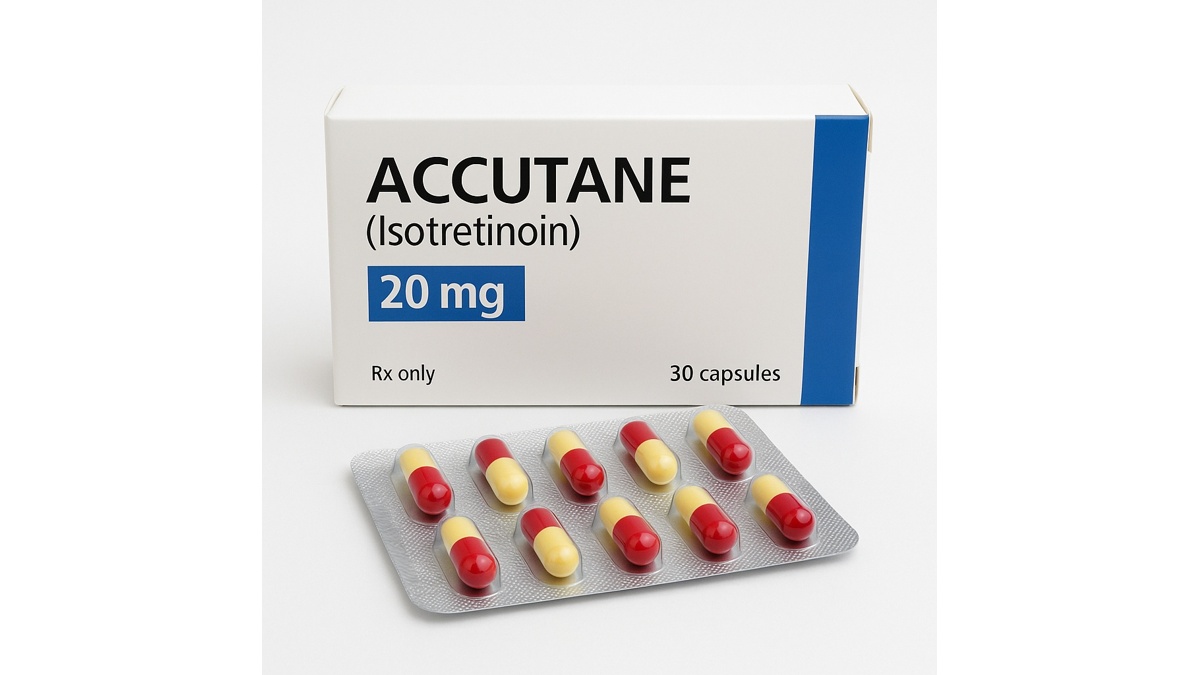
Manufacturer: Various
Known as: Isotretinoin / Accutane
| Package | Price | Per pill |
|---|---|---|
| 10 pills | $58.08 | $0.95 |
| Package | Price | Per pill |
|---|---|---|
| 10 pills | $54.21 | $0.95 |
| Package | Price | Per pill |
|---|---|---|
| 10 pills | $49.94 | $0.95 |
| Package | Price | Per pill |
|---|---|---|
| 10 pills | $46.58 | $0.95 |
| Package | Price | Per pill |
|---|---|---|
| 10 pills | $43.85 | $0.95 |
Read the instructions carefully
Place an order in a few clicks >>
Description of Accutane
Accutane (isotretinoin) is a powerful oral retinoid prescribed for severe acne that does not respond to conventional therapies. If you are asking what is accutane, it is a vitamin A derivative that fundamentally changes the way skin produces oil.
Although the brand Accutane was discontinued in the U.S., isotretinoin remains available in multiple generic and branded versions (e.g., Absorica LD, Claravis). Many people still use the name “Accutane” to describe isotretinoin treatment.
Patients frequently search for accutane before and after photos, and clinical studies confirm its long-term effectiveness. A single course often induces remission lasting years.
Learn more: common causes and symptoms of acne.
How Does Accutane Work?
Patients often ask: how does accutane work? Isotretinoin reduces the size and activity of sebaceous glands, drastically lowering sebum production. This in turn decreases colonization by Cutibacterium acnes (formerly Propionibacterium acnes), prevents clogged pores, and reduces inflammation.
This unique action explains why accutane for acne is reserved for the most severe or resistant cases, especially where scarring risk is high.
Indications and Purpose of Use
Accutane is FDA-approved for:
- Severe nodular or cystic acne
- Acne unresponsive to multiple systemic and topical therapies
- Acne causing scarring or major psychological distress
Off-label uses (with caution):
- Rosacea: there is growing but inconsistent evidence for low-dose isotretinoin; it is not a first-line treatment.
- Hidradenitis suppurativa (HS): current guidelines do not support isotretinoin as a standard therapy; it may be considered only in select cases with limited benefit.
Explore: Updated strategies, including topical retinoids, antibiotics, and biologics.
Accutane Dosage and How to Take
Dosing is weight-based and tailored to individual tolerance.
| Patient Group | Starting Dose | Maintenance Dose | Cumulative Target Dose | Notes |
|---|---|---|---|---|
| Adolescents (12–17 years, non-pregnant) | 0.5 mg/kg/day | Adjust gradually | 120–150 mg/kg total | Careful growth and lab monitoring required |
| Adults (≥18 years) | 0.5 mg/kg/day | 0.5–1 mg/kg/day | 120–150 mg/kg total | Take with food to improve absorption |
| Low tolerance patients | 0.25 mg/kg/day | Increase as tolerated | 120–150 mg/kg total | Slower titration minimizes side effects |
Typical courses last 16–20 weeks. Some patients need a second course if acne relapses.
Accutane Side Effects and Safety
Common side effects include:
- Dryness of lips, skin, and eyes
- Nosebleeds
- Joint or muscle aches
- Initial flare-up of acne
Rare but serious effects:
liver toxicity, elevated triglycerides, mood changes, and teratogenicity.
The phrase “accutane baby” refers to severe birth defects when isotretinoin is taken during pregnancy. To prevent this, the iPLEDGE program strictly regulates prescribing. Since 2023–2024, patients are classified as “patients who can become pregnant” and “patients who cannot,” simplifying pregnancy testing and documentation requirements.
Laboratory Monitoring
In the past, monthly labs were standard. Updated AAD 2024 guidelines recommend:
- Baseline lipid panel and liver function tests
- Repeat at ~2 months
- Further monitoring only if clinically indicated
This individualized approach reduces unnecessary testing while maintaining safety.
Accutane and Alcohol
Alcohol should be avoided during isotretinoin therapy. Both substances affect the liver and lipid levels, increasing the risk of adverse reactions. Patients who drink regularly require closer monitoring and dose adjustments.
Long-Term Results – Accutane Before and After
Many patients consult accutane before and after results to understand what to expect. Clinical data show:
- 80–85% achieve long-term remission after a full course
- Risk of scarring is significantly reduced
- Some patients need repeat courses, particularly those treated at lower doses or at a younger age
Improvement continues even after therapy ends, as the skin stabilizes over months.
Accutane Cost in the USA
The accutane cost varies dramatically:
- Generic isotretinoin may cost under $100/month with discount coupons (GoodRx).
- Branded options like Absorica LD can exceed $800/month without insurance.
- Most patients fall between $150–$300/month, depending on insurance coverage and pharmacy.
This wide range highlights the importance of discussing options with both doctor and pharmacist.
Frequently Asked Questions (FAQ)
What is Accutane used for?
How does Accutane work?
What are the side effects of Accutane?
What is the risk of Accutane baby?
How much does Accutane cost?
What do Accutane before and after results show?
Is Accutane for acne only, or for other conditions too?
Can men take Accutane for acne?
Sources
- MedlinePlus: patient guide to isotretinoin safety and warnings
- FDA: Absorica (isotretinoin) official prescribing information
- American Academy of Dermatology (AAD): isotretinoin treatment overview
- StatPearls: isotretinoin pharmacology, clinical use, monitoring
- GoodRx: cost ranges for isotretinoin generics and brands in the U.S.
- JAAD (2024): updates on acne management and isotretinoin monitoring
